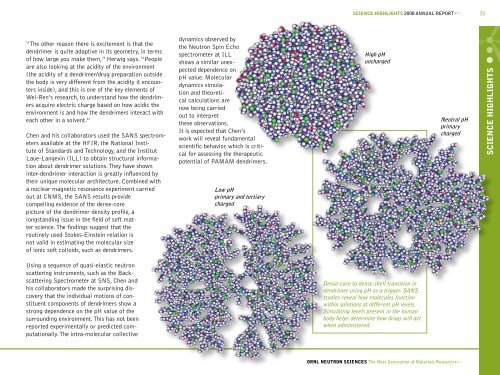Neutron Sciences 2008 Annual Report - 17.79 MB - Spallation ...
Neutron Sciences 2008 Annual Report - 17.79 MB - Spallation ...
Neutron Sciences 2008 Annual Report - 17.79 MB - Spallation ...
You also want an ePaper? Increase the reach of your titles
YUMPU automatically turns print PDFs into web optimized ePapers that Google loves.
“The other reason there is excitement is that the<br />
dendrimer is quite adaptive in its geometry, in terms<br />
of how large you make them,” Herwig says. “People<br />
are also looking at the acidity of the environment<br />
(the acidity of a dendrimer/drug preparation outside<br />
the body is very different from the acidity it encounters<br />
inside), and this is one of the key elements of<br />
Wei-Ren’s research, to understand how the dendrimers<br />
acquire electric charge based on how acidic the<br />
environment is and how the dendrimers interact with<br />
each other in a solvent.”<br />
Chen and his collaborators used the SANS spectrometers<br />
available at the HFIR, the National Institute<br />
of Standards and Technology, and the Institut<br />
Laue-Langevin (ILL) to obtain structural information<br />
about dendrimer solutions. They have shown<br />
inter-dendrimer interaction is greatly influenced by<br />
their unique molecular architecture. Combined with<br />
a nuclear magnetic resonance experiment carried<br />
out at CNMS, the SANS results provide<br />
compelling evidence of the dense-core<br />
picture of the dendrimer density profile, a<br />
longstanding issue in the field of soft matter<br />
science. The findings suggest that the<br />
routinely used Stokes-Einstein relation is<br />
not valid in estimating the molecular size<br />
of ionic soft colloids, such as dendrimers.<br />
Using a sequence of quasi-elastic neutron<br />
scattering instruments, such as the Backscattering<br />
Spectrometer at SNS, Chen and<br />
his collaborators made the surprising discovery<br />
that the individual motions of constituent<br />
components of dendrimers show a<br />
strong dependence on the pH value of the<br />
surrounding environment. This has not been<br />
reported experimentally or predicted computationally.<br />
The intra-molecular collective<br />
dynamics observed by<br />
the <strong>Neutron</strong> Spin Echo<br />
spectrometer at ILL<br />
shows a similar unexpected<br />
dependence on<br />
pH value. Molecular<br />
dynamics simulation<br />
and theoretical<br />
calculations are<br />
now being carried<br />
out to interpret<br />
these observations.<br />
It is expected that Chen’s<br />
work will reveal fundamental<br />
scientific behavior, which is critical<br />
for assessing the therapeutic<br />
potential of PAMAM dendrimers.<br />
Low pH<br />
primary and tertiary<br />
charged<br />
SCIENCE HIGHLIGHTS <strong>2008</strong> ANNUAL REPORT<br />
High pH<br />
uncharged<br />
Dense-core to dense-shell transition in<br />
dendrimer using pH as a trigger. SANS<br />
studies reveal how molecules function<br />
within solutions at different pH levels.<br />
Simulating levels present in the human<br />
body helps determine how drugs will act<br />
when administered.<br />
Neutral pH<br />
primary<br />
charged<br />
ORNL NEUTRON SCIENCES The Next Generation of Materials Research<br />
31<br />
SCIENCE HIGHLIGHTS
















